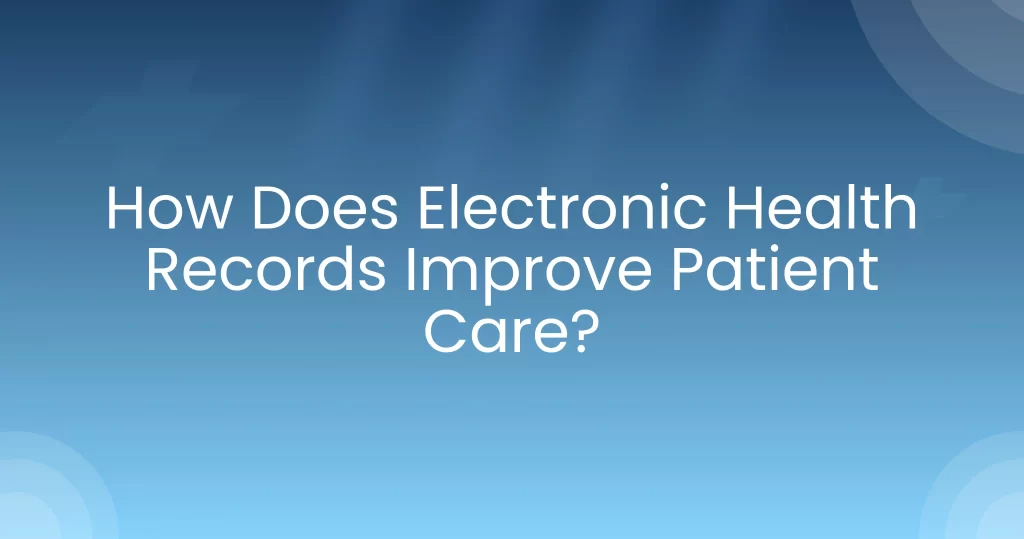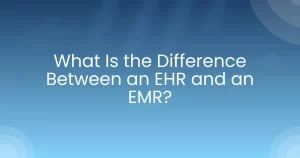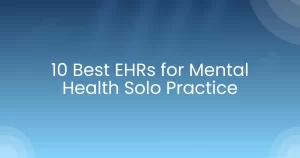Introduction
You know that sinking feeling of losing something important? Now imagine that lost item is a note about a life-threatening allergy, buried deep in a paper chart from ten years back.
Or picture a critical lab result that never makes it to the doctor, it’s just sitting in a silent fax machine, while a patient waits at home, completely unaware.
For decades, that’s exactly how it was. These fragmented paper systems and scattered data weren’t just inconvenient; they directly led to medical mistakes, dangerous delays, and costs that didn’t need to happen.
This is the very problem Electronic Health Records or EHRs, were built to solve. So, what are electronic health records?
Think of an EHR as a patient’s entire paper chart, brought into the digital world. But here’s the crucial part: it’s so much more than that.
Unlike a basic EMR (which is like a digital file cabinet for a single clinic), an EHR is designed to travel. It goes beyond the walls of one practice or hospital.
What it creates is a unified, real-time story of a person’s health, an information that can be securely shared with everyone on their care team, from their primary care doctor to a specialist across town, right down to the hospital lab.
So, how does all this actually help you? Put simply, EHRs turn the healthcare journey into one that’s safer, where your team is effortlessly connected, and where you are finally the main focus.
How Does Electronic Health Records (EHR) Improves Patient Care
EHRs actively improve the entire care journey, leading to smarter decisions, more empowered patients, and smoother-running clinics. It demonstrates clearly how EHR improves patient care, from preventing errors to coordinating treatment.
Here’s how Electronic Health Records (EHR) make care better:
1. Improving Patient Safety & Reducing Errors
When it comes to how EHR improves patient safety, the advantages are immediate and life-saving.
In the old days of paper charts, a patient could get an allergy medicine by accident because of a missed note or a doctor’s handwriting. EHRs are a very important safety net.
The system checks every new prescription against a patient’s known allergies and current medications. Before a prescription is even finalized, the system raises an alert, prompting the clinician to pause and carefully reconsider the choice.
This digital vigilance extends to other areas, like preventing duplicate tests and reducing errors that come from manual data entry. Many systems also include safety dashboards that help teams track and address risks in real-time.
So what does that safety net actually get you? According to CureMD, hospitals using strong EHR systems cut their medication errors by over 50%.
That’s the real story here. It’s not about complicated tech; it’s about having a reliable system that stops a simple error from becoming a patient’s crisis.
2. Enhancing Quality of Care & Outcomes
Think of digital records as a smart assistant for your doctor, one that brings the latest medical evidence right into the exam room.
This means during your appointment, your physician might get a gentle nudge to schedule your overdue mammogram, or they can instantly pull up the most current guidelines for managing your diabetes.
This is where EHRs truly shine in raising the bar for care quality. The system doesn’t just record information, it learns from it. It helps create a cycle of continuous improvement by tracking what works, spotting any missing steps in a care plan, and showing clinics how their performance stacks up against national standards.
On a personal level, this means your long-term health conditions can be managed more proactively. On a larger scale, it gives health networks a clear picture of community health trends, allowing them to improve care for everyone.
And this isn’t just a theory, it’s proven. Research including a major study in the Journal of the American Medical Informatics Association shows that clinics using EHRs see real, measurable gains, from getting more patients in for preventative screens to better managing chronic diseases.
3. Improving Care Coordination & Continuity
Perhaps the most profound change is how EHRs have revolutionized care coordination. Managing your health often means seeing multiple providers in different locations.
Back then, it felt a lot like a stressful game of telephone. One clinic might not see the test results from another, so patients ended up repeating the same tests. It would be easy for important information to get lost along the way.
EHRs solve this by ensuring everyone on your team is literally on the same page. Your primary care doctor, your specialist, and your physical therapist all have secure, instant access to the same up-to-date story of your health.
This seamless connection is very important. It makes transitions, like being discharged from the hospital, much safer and smoother. It’s also the basis of modern telehealth, which lets you have a visit from afar while still having your whole medical background available.
In short, EHRs work to ensure you receive consistent, connected care, no matter where your journey takes you.
4. Boosting Efficiency, Workflow & Access
What’s great is that EHRs help your doctor just as much as they help you. And when your care team spends less time on paperwork, they can spend more time with you.
Here’s how that works day-to-day:
- All-in-One System: Test orders, payments, and scheduling are all linked in one place. This helps the clinic run easily and cuts down on mistakes.
- Shorter Waiting Time: Clinics can cut down on wait times so you can spend more time with your doctor and less time in the waiting room.
- Online Care Management: Take charge of your care online: A patient portal lets you make visits and ask for refills at any time, from your computer or phone.
So, what does all this add up to? By taking care of the administrative busywork, EHRs give your care team a priceless gift: time. And they give that time right back to you.
This means more moments for your doctor to listen, to explain, and to provide the compassionate, focused care you deserve.
5. Enhancing Patient Engagement & Empowerment
Today, more people want to be active partners in managing their health, and Electronic Health Records (EHRs) provide the essential tools to make that possible. The electronic health records benefits include access to lab results, appointment tracking, and direct messaging with providers.
The main gateway for this is the patient portal, a secure online website that puts your health information right at your fingertips.
With a portal, you can log in to see your latest lab results, review your vaccination history, and read the notes from your last visit. This new level of transparency changes everything.
Instead of wondering about your health, you can see the facts for yourself. This knowledge helps you have more productive and informed conversations with your doctor about your care.
But the benefits go beyond just viewing information. These portals often include secure messaging, allowing you to ask your care team a quick question without needing an appointment.
Many also offer features to help you track symptoms or manage medications. When you are this involved in your own healthcare journey, you are more likely to stick with your treatment plan and, ultimately, feel more satisfied with your care.
Evidence & Use Cases
The benefits of EHRs aren’t just ideas on paper, they’re already making a real difference in hospitals and clinics around the world. Here’s what the evidence shows:
By the Numbers
- Hospitals that use advanced EHR systems have cut medication errors by more than 50%.
- Clinics with strong EHR adoption see fewer patients coming back for readmissions.
- Health networks save money by reducing duplicate tests and cutting down on paperwork.
- Patient satisfaction goes up when people can log in to a portal to see results or message their doctor.
What People Are Saying
Doctors and nurses report feeling better prepared during visits, thanks to having complete records and built-in decision-support tools.
Patients say they feel more confident and in control when they can view their test results and reach their care team online.
A Global Shift
This isn’t just happening in one country. It’s a clear example of how EHRs have affected the way healthcare is provided, connecting hospitals, clinics, and patients worldwide.
From the UK’s National Health Service to hospitals in India and Europe, shared digital records are helping entire health systems provide safer, more coordinated, and more continuous care.
Addressing Challenges & Critiques
Digital records are already changing healthcare for the better, but they’re not finished evolving. By paying attention to what needs work, we can make sure this technology reaches its full potential for every patient and provider.
Even with all the benefits, some areas still need improvement:
- Security: Personal information about health needs strong security to stay safe and private.
- Compatibility: It should be easy for hospitals and clinics to share information with each other so that all doctors can see the whole picture of a patient’s health.
- Efficiency: EHRs should simplify a doctor’s day, not add extra steps, which frees up more time for patients.
- Accessibility: All people should be able to use these tools, even those who aren’t very good with technology or don’t always have good internet access.
By working on these challenges, the future of healthcare looks brighter. One where technology makes things safer, simpler, and more focused on people.
Conclusion
Electronic health records are like a trusted co-pilot in healthcare. They support doctors by ensuring information is always accurate, streamlining their daily tasks, and empowering patients to take an active role in their own health.
They watch for potential dangers, navigate toward proven treatments, and keep your entire care team headed in the same direction.
On top of that, they free up doctors from tedious paperwork and give you direct access to your health information.
The systems that truly stand out are the ones built around people. They work like a trusted vault for your private information, help doctors focus on you instead of their screens, and are designed to be straightforward for everyone, whether you’re tech-savvy or not.
That’s why the direction forward is so important. The goal for everyone involved should be to champion technology that connects more intelligently and always prioritizes the human side of healing.
After all, the real success of these systems isn’t about storing data, it’s about creating a healthcare experience that is safer, smoother, and genuinely focused on you.
FAQs
How does EHR improve patient care?
By pulling your health information into one secure record, EHRs give your doctors the full picture. As a result, they can make smarter decisions, prevent potential errors, and deliver care that is both safer and better coordinated.
How do electronic health records improve the quality of care?
EHRs equip your doctors with data-driven insights, helping to ensure your care follows the most effective path and your health is actively managed for the best results.
How has EHR improved healthcare?
EHRs have connected a system once run on paper, enabling better teamwork among your doctors, proactive health management, and convenient options like telehealth. This shows how EHR has improved healthcare over the past decade.
How have EHRs changed healthcare delivery?
They’ve made it a truly team-based effort. Every doctor you see can now work from the same, up-to-date information, giving you consistent and informed treatment.
Why is EHR important?
EHRs are vital because they give your doctor instant, secure access to your accurate health history, forming the foundation for safe and effective modern treatment.
Why are electronic health records important for patients?
They create a safer experience and put you in control by giving you direct access to your health information, helping you become an active partner in your care.
How does EHR improve patient safety?
They act as a safety net, automatically alerting your doctor to drug allergies or dangerous interactions and helping to prevent unnecessary duplicate tests.
What is the main use of EHR in healthcare?
Its core use is to serve as a single, shared source of truth for your health history, supporting everything from diagnosis and treatment to billing and communication.
What are the key advantages of using an EHR?
The biggest advantages of EHR are enhanced safety, better care quality, seamless coordination between your doctors, and tools that empower you to manage your own health.
What are the overall benefits of EHRs?
The overall benefits are a significant reduction in medical errors, more consistent treatments, less administrative work for your care team, and easy online access to your doctor and records for you.
What are the specific benefits of EHR for patients?
For you, the benefits are a stronger sense of safety and control, a perfectly coordinated care team, and the ability to handle appointments and see test results online, on your own time.



